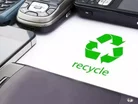Infographic: How Can We Get Australia's E-Waste Situation In Check?

As technology continues to develop at break-neck speed, the world needs to figure out better plans for e-waste. As the country with the highest users of e-waste—19.71 kg per person per year—Australia’s legislative efforts, as well as industry’s and consumer’s, need to focus on creating a better solution for e-waste.
The Economist Intelligence Unit recently released research at the request of Australia and New Zealand Recycling Platform (ANZRP) depicting how much e-waste Australians generate, and what other countries are doing successfully to combat the rising e-waste in their countries.
The research shows that the last decade has been a period of great growth for e-waste solutions, but that compared to other developed markets, Australia is just in its infancy.
“As the technological revolution marches forward, e-waste systems will need to adapt accordingly and our report highlights that for Australia to increase the level of systemic e-waste recycling, there needs to be a greater focus on ‘shared responsibility’, as not only producers, but governments, retailers, business and consumers play a critical role in the e-waste debate,” said John Ferguson, Senior Economist, EIU and author of the report.
“The report strongly indicates to us that that there needs to be a greater sense of urgency from some parties,” said Carmel Dollisson, CEO of ANZRP. “A higher level of shared responsibility needs to be taken, especially by local and state governments, who need to develop immediate action plans to take control of e-waste in their system.”
Read related articles from Business Review Australia:
Help Save The Earth & Your Budget: Energy Efficiency For The Hottest Months
The Future Landscape of Technology: Australia's TEchnological Landscape
We all play a critical role, for example, local governments can work towards driving policies that incentivise the recycling behaviour among households, the retailer sector can act as a collection point in the e-waste system, and regulators can help to drive these initiatives to ensure that responsibility is taken in every link of the chain.”
Currently there is no long-term, sustainable solution. The included infographic below however, details what could be. Countries like Japan, Finland and Germany have sophisticated e-waste programs that can predict what exactly Australia needs to become more e-sustainable.

Join us on Facebook.
Like us on Twitter.



